Attached files
| file | filename |
|---|---|
| 8-K - FORM 8-K - FIFTH THIRD BANCORP | d441376d8k.htm |
 ©
Fifth Third Bank | All Rights Reserved
Bank of America Merrill Lynch
Banking & Financials Conference
Daniel T. Poston
Executive Vice President & Chief Financial Officer
November 14, 2012
Refer to earnings release dated October 18, 2012
and 10-Q dated November 7, 2012 for further information
Exhibit 99.1 |
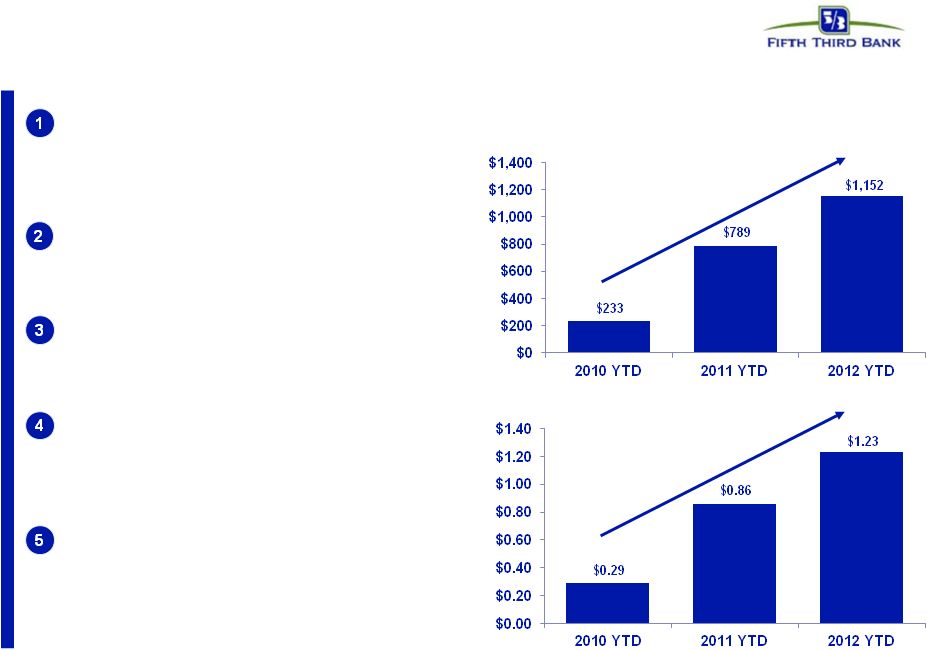 2
©
Fifth Third Bank | All Rights Reserved
A strong franchise showing momentum
Strong results underscored by
continued loan growth, solid fee
income, expense control, and ongoing
improvement in credit metrics
Traditional banking model moderate
risk profile and strong execution
contribute to above average returns
New product offerings consistent with
our mission, our customer value
proposition, and regulatory reform
Return capital from robust internal
capital generation through
appropriate dividend payout and
share repurchase plans
Current and forecasted fully phased-in
pro-forma capital ratios would
substantially exceed new fully
phased-in well-capitalized minimums
Earnings Growth
Net income available to common shareholders ($MM)
Diluted EPS |
 3
©
Fifth Third Bank | All Rights Reserved
•
Continued strong loan production
–
Rates on loan originations lower but loan
interest income stable
•
Continue to provide customers with products /
solutions they find valuable
•
Careful management of liability costs
–
Disciplined pricing on deposits
–
Continued evaluation of term liabilities and
capital instruments
•
Strong mortgage banking results
•
Mortgage risks manageable
–
Typical quarterly mortgage repurchase cost
~$20MM
–
No mortgage securitizations outstanding
•
Strong profitability and capital in excess of fully
phased-in
Basel
III
standards
today
–
Believe we are well positioned to maintain
strong capital while providing meaningful
distributions to shareholders*
Environment characterized by low growth
expectations and low interest rates
•
Prolonged low-rate environment, coupled
with modest economic growth
•
Lower securities reinvestment yields on
portfolio cash flows
•
Strong deposit flows
•
Competitive dynamics
•
Elevated mortgage refinance activity
•
Firms facing significant costs related to
mortgage securitizations, GSE
repurchases, private label mortgage
repurchases
•
Higher capital standards; limitations on
dividend payout ratios; capital building
beyond targeted / required levels
•
Economic uncertainty including fiscal
cliff and impact on business activity;
concerns about European financial
system
Fifth Third is well-positioned to deal with current environmental
challenges Characteristics of current environment
Fifth Third’s response / position
* Subject to 2013 Comprehensive Capital Analysis & Review final rules; subject
to Board of Directors and regulatory approval. •
Low exposure to European banks (see slide 22) |
 4
©
Fifth Third Bank | All Rights Reserved
NII results reflect continued moderate NIM
pressure offset by balance sheet growth
* Represents purchase accounting adjustments included in net interest income.
^ Estimate; funding (DDAs + interest-bearing liabilities); liabilities
attributed to fixed or floating using terms and expected beta
Fixed / Floating Portfolio
•
3Q12 NII included $10MM of non-recurring benefits (4
bps positive impact to NIM)
•
NIM pressure created by low rate environment, higher
prepayment speeds, repricing in securities and loan
portfolios, and modest natural asset sensitivity, but
overall is expected to be manageable
•
Spreads on new originations of variable rate assets
consistent with historical spreads
Interest-Earning
Assets
Funding^
Fixed
~55-60%
NII and NIM (FTE)
($MM)
Loans
50%
Loans
33%
Investment
Portfolio 3%
Trend: fixed rate loan origination coupons
relative to fixed portfolio weighted avg
Larger portfolio repricing effects
–
Emphasis on variable rate C&I lending
•
Coupons on new fixed rate loan originations
converging with portfolio average coupons
•
Current trends have pressured net interest income
levels, but expect to mitigate much of impact with
continued loan growth and liability management
Investment
Portfolio
14% |
 5
©
Fifth Third Bank | All Rights Reserved
Balance sheet growth mitigates rate environment
•
Core deposit to loan ratio of 99% consistent with
3Q11
–
DDAs up 15% year-over-year
–
Consumer average transaction deposits up 5%
year-over-year
–
Commercial average transaction deposits up
10% year-over-year
Average loan growth ($B)^
Average core deposit growth ($B)
83
79
82
78
^ Excludes loans held-for-sale
Note: Numbers may not sum due to rounding
80
81
82
82
83
•
Growth driven by C&I and residential mortgage
loans; portfolios in run-off mode are of moderate
size
–
Commercial line utilization stable at 32%;
potential source of future growth
•
CRE portfolio continues to run-off, with modest
selective current origination volume
•
Managing auto volumes to ensure appropriate
returns; spread pressure due to competition
•
Branch mortgage refi product has FICO over 780,
LTV ~60% and avg. term ~15 years while yielding
above market rates due to process convenience
82
•
Short-term wholesale borrowings represent only
7% of total funding |
 6
©
Fifth Third Bank | All Rights Reserved
Strength in C&I loan growth
C&I Loans/Average Assets*^
C&I Spread to 1-month LIBOR
Peer average: 24%
Continued demand in large corporate and mid-
corporate space
Reduction in portfolio yields driven by mix shift
toward higher-quality loans, portfolio effects of
repricing, and pressure on new origination yields
C&I loans as a percent of total commercial loans
was 71% at 3Q12 versus peer average of 63%
C&I production continues to be broad based across
industries and sectors
—
Strength in manufacturing and healthcare
industries
—
Launch of Energy Lending vertical expected to
contribute to future growth in C&I
C&I spreads remain stable
C&I Portfolio^ ($B)
^ Presented on an average basis; Excluding held-for-sale loans. Source: SNL Financial and Company
Reports. Peer average includes: BBT, CMA, HBAN, KEY, MTB, PNC, RF, STI, USB, WFC, and ZION
* ZION & BBT exclude government guaranteed loans; ZION presented as end of period data. |
 7
Fifth Third Bank | All Rights Reserved
Strong revenue and profit generation
Source: SNL Financial and Company Reports. Peer median includes: BBT, CMA, HBAN,
KEY, MTB, PNC, RF, STI, USB, WFC, and ZION ^ Excludes
$3MM,
$10MM,
$46MM,
and
$56MM
positive
valuation
adjustment
on
the
Vantiv
warrant
and
put
option
in
3Q11,
4Q11,
1Q12, and 2Q12, respectively, and a $16 million negative
valuation adjustment on the Vantiv warrant in 3Q12, as well as $115MM in gains from
Vantiv's IPO and $34MM charge related to Vantiv's debt refinancing in 1Q12. *
Non-GAAP measure. See Reg. G reconciliation in the Appendix to the presentation.
Revenue
^
/ Avg. Int. Earning Assets
PPNR
^*
/ Avg. Int. Earning Assets
3Q12 returns strong relative to peers
NII / Total Assets
Noninterest Income^ / Total Assets
•
Business mix provides higher than average
diversity among spread and fee revenues (40+%
of revenue)
•
Relatively strong margin and relatively high fee
income contribution drives strong revenue and
PPNR generation profitability despite sluggish
economy
•
Income from ownership in Vantiv $25MM in
3Q12 (full year 2011 quarterly avg ~$14MM,
despite selling ~10% in 1Q12)
6.33%
5.82%
6.18%
6.02%
6.00%
6.25%
ROAA
ROAE
2.50%
1.86%
2.29%
2.31%
2.31%
2.13%
0.0%
0.5%
1.0%
1.5%
2.0%
2.5%
3.0%
3Q11
4Q11
1Q12
2Q12
3Q12
3Q12
Peer Median
3.65%
3.67%
3.61%
3.56%
3.56%
3.58%
2.68%
2.15%
2.57%
2.46%
2.69%
2.42%
0.0%
1.0%
2.0%
3.0%
4.0%
5.0%
6.0%
7.0%
3Q11
4Q11
1Q12
2Q12
3Q12
3Q12
Peer Median
1.23%
1.20%
1.28%
FITB
Peer Median
ROAA
Adjusted ROAA^
10.4%
10.1%
10.9%
FITB
Peer Median
ROAE
Adjusted ROAE^
©
Fifth Third Bank | All Rights Reserved |
 8
Strong mortgage banking results
•
Record origination fees and gain on
loan sales in 3Q12
•
Highest ranking among all servicers
and peer groups in Fannie Mae’s
2011 STAR
TM
Program for servicing
performance
Looking forward:
•
Stronger originations / deliveries in
4Q12 vs 3Q12
–
Results should remain robust
while rates remain low
•
Gain on sale margins benefitting
from:
–
Strong demand
–
Industry capacity constraints
–
Strong mortgage-backed securities
pricing
•
HARP 2.0 originations expected to
remain similar percentage of total
originations in 4Q12 vs 3Q12
Mortgage originations and gain-on-sale margins*
Mortgage Banking Revenue ($MM)
* Gain-on-sale margin represents margin on loans originated for sale.
0.00%
0.50%
1.00%
1.50%
2.00%
2.50%
3.00%
3.50%
4.00%
4.50%
5.00%
$0
$1
$2
$3
$4
$5
$6
$7
$8
3Q11
4Q11
1Q12
2Q12
3Q12
Originations for sale
Originations HFI
Margins*
($B)
119
152
174
183
226
59
58
61
63
62
(34)
(47)
(46)
(41)
(48)
34
(7)
15
(22)
(40)
3Q11
4Q11
1Q12
2Q12
3Q12
Orig fees and gains on loan sales
Gross servicing fees
Servicing rights amortization
MSR valuation adjustments
$178
$200
$183
$156
$204
©
Fifth Third Bank | All Rights Reserved |
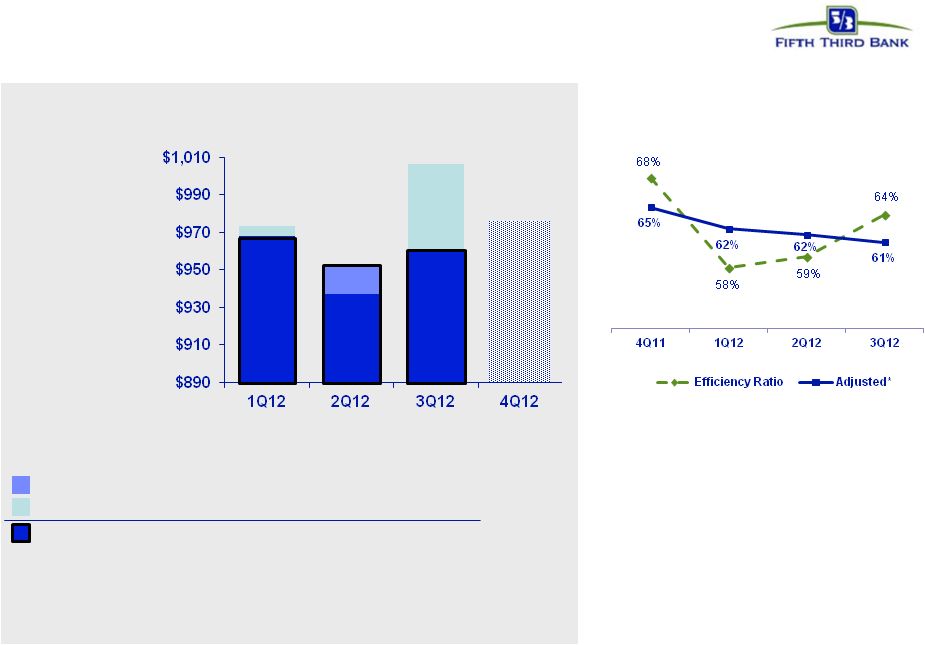 9
©
Fifth Third Bank | All Rights Reserved
Disciplined expense management
•
Expect similar adjusted efficiency ratio in
4Q12; target mid-50% in normalized
environment (with higher interest rate
environment)
2012 expense trend ($MM)
* Non-recurring items described on page 18 in the appendix to this
presentation. Reported expense
Increasing expense
Non-recurring items*:
Adjusted expense
Decreasing expense
$973
$937
$1,006
$23
$17
$5
($28)
($2)
($50)
$968
$952
$961
Managing expenses carefully in response to revenue
environment; continuous process of expense evaluation
Efficiency ratio trend
–
Current impact of credit costs on
revenue and expenses; impact of
regulatory reforms (e.g., debit
interchange) not fully mitigated
–
Reflects below-capacity balance sheet
and lower revenue than we expect and
can support longer term |
 10
©
Fifth Third Bank | All Rights Reserved
Credit trends continue to improve
with strong reserve coverage levels
Source: SNL Financial and Company Reports. Data as of 3Q12. HFI NPLs exclude loans
held-for-sale and also exclude covered assets for BBT, USB, and ZION
* HBAN, KEY, PNC, USB, WFC include the implementation of newly issued 3Q12 OCC
guidance which requires write-down of performing consumer loans restructured in bankruptcy to
collateral value. The light blue section indicates the additional charge-offs
due to this guidance. Continued
decline
in
problem
assets
and
corresponding
decline
in
charge-offs
combined
with strong reserves on an absolute and relative basis
NPLs / Loans
Peer average: 1.6%
Loan loss reserves / Loans
Peer average: 2.0%
Net charge-off ratio
Peer average: 0.9%
Reserves / NPLs
Peer average: 131% |
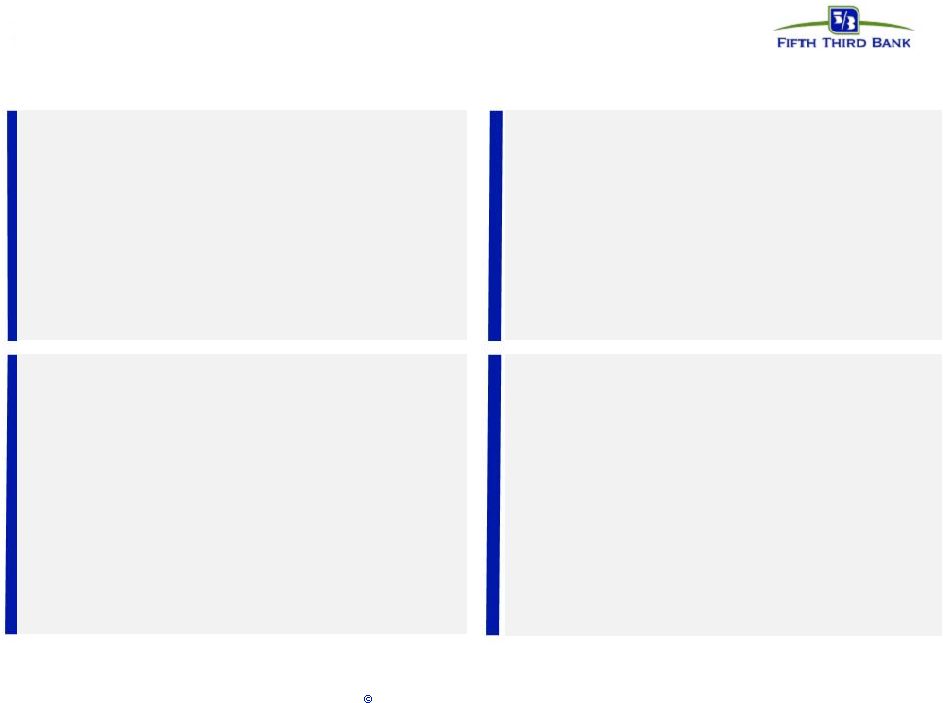 11
Fifth Third Bank | All Rights Reserved
Capital management philosophy
* Subject to Board of Directors and regulatory approval
Organic growth opportunities
•
Support growth of core banking franchise
•
Continued loan growth despite sluggish
economy
Strategic opportunities
*
•
Prudently evaluate franchise including
increasing density in core markets via
disciplined acquisitions or selective de
novos
•
Expect future acquisition opportunities
although activity remains muted in near-term
•
Attain top 3 market position in 65% of
markets or more longer term
Return to more normal dividend policy*
•
Strong levels of profitability would support
higher dividend than current level
•
Move towards levels more consistent with
Fed’s near-term payout ratio guidance of
30%
•
Quarterly dividend increased to $0.10 in
3Q12
Repurchases / Redemptions
*
•
Common share repurchases to limit and
manage growth of excess capital levels
Expect capital philosophy to remain consistent
pending evaluation of results in 2013 CCAR process
Capital Deployment
Capital Return
–
Manage capital in light of regulatory
environment, other alternatives,
maintenance of desired / required buffers,
stock price
–
$600MM of potential repurchases through
1Q13 ($350MM ASR completed in October;
$125MM ASR entered into in November)
•
Redeemed $1.4bn in TruPS in 3Q12 |
 12
©
Fifth Third Bank | All Rights Reserved
Capital position remains strong
* The pro forma Tier I common equity ratio is management’s estimate based upon
its current interpretation of the three draft Federal Register notices proposing enhancements to regulatory
capital requirements published in June 2012. The actual impact to the
Bancorp’s Tier I common equity ratio may change significantly due to further clarification of the agencies proposals or
revisions to the agencies final rules, which remain subject to public
comment. Proposed new U.S. capital standards would have manageable impact, if
adopted Primary Basel III Adjustments*
Proposed
fully
phased in
buffered
minimum
of 7.0%
Basel III Impacts
•
3Q12 Tier 1 common equity ratio of
9.67% under Basel I
Current
•
Capital impact increase primarily
from inclusion of AOCI
•
RWA increase primarily from 1-4
family senior and junior lien
residential mortgages,
commitments under one year
Estimated NPR Impact
•
Pro forma 3Q12 Tier 1 common
equity ratio of ~9%* under Basel III
•
Does not include the effect of any
mitigating actions Fifth Third may
take
Pro forma Tier 1 Common Equity
NPR Capital Impact
~45 bps +/-
NPR RWA Impact
~(110 bps) +/-
Total Tier 1
Change ~(65 bps) +/-
Tier 1 Common Equity |
 13
©
Fifth Third Bank | All Rights Reserved
Fifth Third’s balance sheet and business model
relatively advantaged under new capital standards
Fifth Third’s capital position already well in excess of any established
standards, likely standards, and most peers 5.0%
7.0%
4.5%
Unofficial CCAR supervisory reference minimum
3Q12 Pro forma Tier 1 common / RWA
U.S. proposed Basel III**
3Q12 Tier 1 common / RWA
Basel I
2019 Basel III buffered minimum
2015 Basel III minimum
Not disclosed
High
7%
range
Source: SNL Financial and company reports (financial data as of 3Q12).
* Data sourced form SNL Financial 2Q12. In 2Q12, HBAN stated Basel III Tier 1 common ratio
would be negatively impacted by approximately 150 basis points. ** Note: Fifth
Third’s pro forma Tier I common equity ratio is management’s estimate based upon its current interpretation of the three draft Federal Register notices proposing
enhancements to regulatory capital requirements published in June 2012. The actual impact to
the Bancorp’s Tier I common equity ratio may change significantly due to further
clarification of the agencies proposals or revisions to the agencies final rules, which
remain subject to public comment. Not adjusted for potential mitigation efforts. ^
CMA 3Q12 earnings call stated “Tier 1 capital ratio is estimated to be comfortably above the new 8.5% regulatory standard”.
|
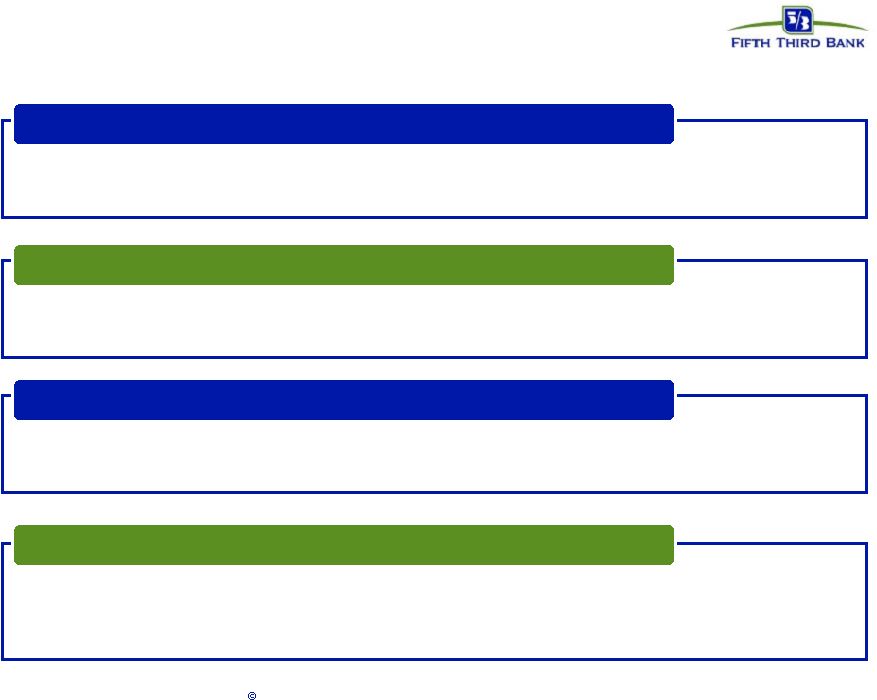 14
Fifth Third Bank | All Rights Reserved
Well-positioned for the future
•
Fifth Third monitors liquidity at the Holding Company over a 24-month period,
and manages liquidity based on the coverage of contractual obligations
without accessing the capital markets or receiving dividends from the Bank entity
•
Fifth Third has completely exited all crisis-era government support
programs Superior capital and liquidity position
•
NCOs of 0.75%; 3.1x reserves / annualized NCOs
•
Substantial reduction in exposure to CRE since 1Q09; relatively low CRE exposure
versus peers •
Very low relative exposure to areas of concern, e.g. European financials, mortgage
repurchase risk Proactive approach to risk management
•
Traditional commercial banking franchise built on customer-oriented localized
operating model •
Strong market share in key markets with focus on further improving density
•
Fee income ~43% of total revenue
Diversified traditional banking platform
•
PPNR has remained strong throughout the credit cycle
•
PPNR substantially exceeds annual net charge-offs (364% PPNR / NCOs^ in
3Q12) •
1.2% ROAA; 13% return on average tangible common equity^
Industry leader in earnings power
^ Non-GAAP measure. See Reg. G reconciliation in the Appendix to the
presentation. –
Fifth Third is one of the few large banks that have no TLGP-guaranteed debt to refinance in
2012 |
 15
©
Fifth Third Bank | All Rights Reserved
Cautionary statement
This
report
contains
statements
that
we
believe
are
“forward-looking
statements”
within
the
meaning
of
Section
27A
of
the
Securities
Act
of
1933, as amended, and Rule 175 promulgated thereunder, and Section 21E of the
Securities Exchange Act of 1934, as amended, and Rule 3b-6 promulgated
thereunder. These statements relate to our financial condition, results of operations, plans, objectives, future
performance
or
business.
They
usually
can
be
identified
by
the
use
of
forward-looking
language
such
as
“will
likely
result,”
“may,”
“are
expected to,”
“is anticipated,”
“estimate,”
“forecast,”
“projected,”
“intends to,”
or may include other similar words or phrases such as
“believes,”
“plans,”
“trend,”
“objective,”
“continue,”
“remain,”
or
similar
expressions,
or
future
or
conditional
verbs
such
as
“will,”
“would,”
“should,”
“could,”
“might,”
“can,”
or similar verbs. You should not place undue reliance on these statements, as they
are subject to risks and uncertainties,
including
but
not
limited
to
the
risk
factors
set
forth
in
our
most
recent
Annual
Report
on
Form
10-K.
When
considering
these
forward-looking statements, you should keep in mind these risks and
uncertainties, as well as any cautionary statements we may make. Moreover,
you should treat these statements as speaking only as of the date they are made and based only on information then actually
known to us.
There are a number of important factors that could cause future results to differ
materially from historical performance and these forward- looking
statements. Factors that might cause such a difference include, but are not limited to: (1) general economic conditions and
weakening in the economy, specifically the real estate market, either nationally or
in the states in which Fifth Third, one or more acquired entities and/or the
combined company do business, are less favorable than expected; (2) deteriorating credit quality; (3) political
developments, wars or other hostilities may disrupt or increase volatility in
securities markets or other economic conditions; (4) changes in the interest
rate environment reduce interest margins; (5) prepayment speeds, loan origination and sale volumes, charge-offs and loan
loss provisions; (6) Fifth Third’s ability to maintain required capital levels
and adequate sources of funding and liquidity; (7) maintaining capital
requirements may limit Fifth Third’s operations and potential growth; (8) changes and trends in capital markets; (9) problems
encountered by larger or similar financial institutions may adversely affect the
banking industry and/or Fifth Third; (10) competitive pressures
among
depository
institutions
increase
significantly;
(11)
effects
of
critical
accounting
policies
and
judgments;
(12)
changes
in
accounting policies or procedures as may be required by the Financial Accounting
Standards Board (FASB) or other regulatory agencies; (13)
legislative
or
regulatory
changes
or
actions,
or
significant
litigation,
adversely
affect
Fifth
Third,
one
or
more
acquired
entities
and/or
the
combined
company
or
the
businesses
in
which
Fifth
Third,
one
or
more
acquired
entities
and/or
the
combined
company
are
engaged,
including
the
Dodd-Frank
Wall
Street
Reform
and
Consumer
Protection
Act;
(14)
ability
to
maintain
favorable
ratings
from
rating
agencies;
(15)
fluctuation
of
Fifth
Third’s
stock
price;
(16)
ability
to
attract
and
retain
key
personnel;
(17)
ability
to
receive
dividends
from
its
subsidiaries;
(18)
potentially
dilutive
effect
of
future
acquisitions
on
current
shareholders’
ownership
of
Fifth
Third;
(19)
effects
of
accounting
or
financial
results
of
one
or
more
acquired
entities;
(20)
difficulties
from
the
separation
of
or
the
results
of
operations
of
Vantiv,
LLC from Fifth Third; (21) loss of income from any sale or potential sale of
businesses that could have an adverse effect on Fifth Third’s earnings
and future growth; (22) ability to secure confidential information through the use of computer systems and telecommunications
networks; and (23) the impact of reputational risk created by these developments on
such matters as business generation and retention, funding and
liquidity. You
should
refer
to
our
periodic
and
current
reports
filed
with
the
Securities
and
Exchange
Commission,
or
“SEC,”
for
further
information
on other factors, which could cause actual results to be significantly different
from those expressed or implied by these forward-looking statements.
|
 16
Fifth Third Bank | All Rights Reserved
Appendix |
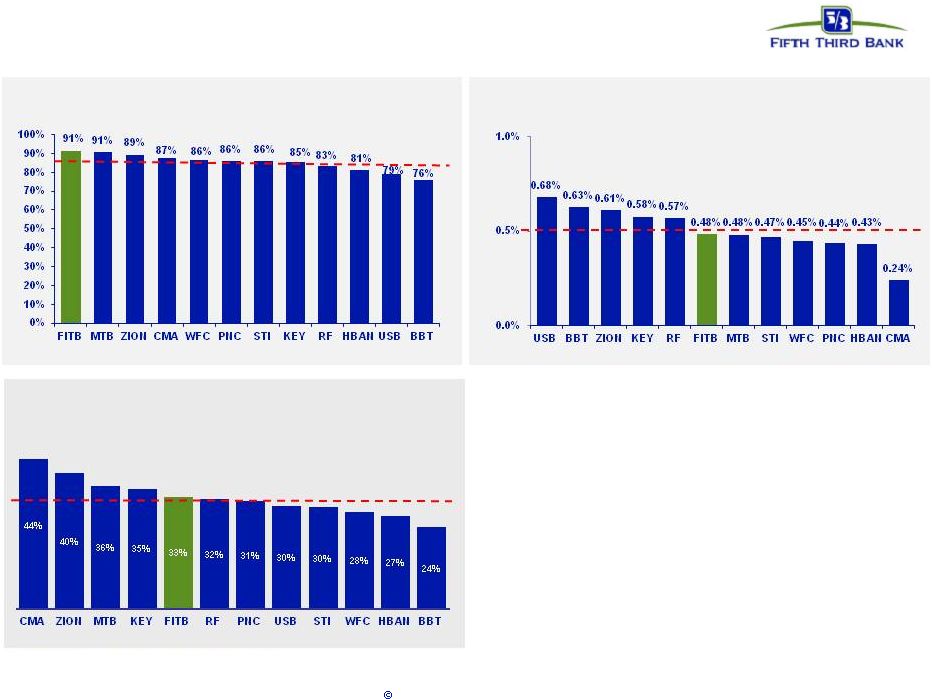 17
Fifth Third Bank | All Rights Reserved
Core funded balance sheet and pricing discipline
•
Deposit-rich core funding mix supports
relatively low cost of funds
–
High percentage of funding base in low cost
transaction deposits and noninterest-
bearing DDA accounts
–
Low reliance on wholesale funding
SOURCE: SNL Financial and Company Reports. Data as of 3Q12
Transaction deposits defined as DDA, NOW and Savings/MMDA accounts; Cost of Funds
defined as interest incurred on interest-bearing liabilities as a percentage of average noninterest-bearing deposits and interest-
bearing liabilities; Transaction deposits/Total deposits presented on an average
basis; DDA/Total deposits presented on end-of-period basis. Transaction
Deposits / Total Deposits Peer average
85%
Cost of Funds
Peer average
0.51%
DDA/Total Deposits
Peer average
32% |
 18
Fifth Third Bank | All Rights Reserved
PPNR trend
•
PPNR of $568MM down 11% from 2Q12 levels and
8% from prior year
•
Adjusted PPNR of $593MM, including positive
adjustments totaling $25MM, down 1% sequentially
and 7% year-over-year
—
Including 3Q12 mortgage repurchase reserve
build, PPNR of $617MM
Efficiency ratio
PPNR reconciliation
Pre-tax pre-provision earnings*
($ in millions)
Income before income taxes (U.S. GAAP) (a)
Add: Provision expense (U.S. GAAP) (b)
PPNR (a) + (b)
Adjustments
to
remove
(benefit)
/
detriment^:
In
noninterest
income:
Vantiv IPO gain
Vantiv debt refinancing
Valuation of 2009 Visa total return swap
Vantiv warrants & puts
Valuation of bank premises moved to HFS
Litigation reserve additions in revenue
Sale of certain Fifth Third funds
Securities (gains) / losses
In
noninterest
expense:
Debt extinguishment (gains) / losses
Non-income tax related assessment resolution
Sale of certain Fifth Third funds
Termination of certain borrowing & hedging transactions
Severance expense
FDIC insurance expense
Gain on sale of affordable housing
Litigation reserve additions in expense
Adjusted PPNR
Credit-related
items^^:
In noninterest income
In noninterest expense
Credit-adjusted PPNR**
3Q11
4Q11
1Q12
2Q12
3Q12
$530
$418
$603
$565
$503
87
55
91
71
65
$617
$473
$694
$636
$568
-
-
(115)
-
-
-
-
34
-
-
17
54
19
11
1
(3)
(10)
(46)
(56)
16
-
-
-
17
-
-
-
-
6
-
-
-
-
-
(13)
(26)
(5)
(9)
(3)
(2)
-
-
9
-
26
-
-
(23)
-
-
-
-
-
-
2
28
-
-
-
-
-
-
6
-
-
-
-
-
(9)
-
-
-
-
(8)
(5)
4
19
13
2
-
$637
$531
$582
$596
$593
25
33
14
17
14
45
44
34
40
59
$707
$608
$630
$653
$666
* Non-GAAP measure. See Reg. G reconciliation on pages 23 and 24.
** There are limitations on the usefulness of credit-adjusted PPNR, including the significant
degree to which changes in credit and fair value are integral, recurring components of the
Bancorp’s core operations as a financial institution. This measure has been included herein to
facilitate a greater understanding of the Bancorp’s financial condition. ^ Prior quarters
include similar adjustments. ^^ See page 19 for detailed breakout of credit-related
items. # 61% also excluding $22MM 3Q12 mortgage repurchase reserve build
|
 19
Fifth Third Bank | All Rights Reserved
Credit-related costs
In noninterest income ($MM)
In noninterest expense ($MM)
Actual
($ in millions)
3Q11
4Q11
1Q12
2Q12
3Q12
Gain / (loss) on sale of loans
$3
$9
$5
$8
$2
Commercial loans HFS FV adjustment
(6)
(18)
(1)
(5)
(3)
Gain / (loss) on sale of OREO properties
(21)
(22)
(17)
(19)
(11)
Mortgage repurchase costs
(2)
(1)
(2)
(2)
(2)
Total credit-related revenue impact
($25)
($33)
($14)
($17)
($14)
Actual
($ in millions)
3Q11
4Q11
1Q12
2Q12
3Q12
Mortgage repurchase expense
$19
$18
$15
$18
$36
Provision for unfunded commitments
(10)
(6)
(2)
(1)
(2)
Derivative valuation adjustments
4
(5)
(4)
(0)
(2)
OREO expense
7
8
5
5
6
Other problem asset related expenses
25
28
19
19
21
Total credit-related operating expenses
$45
$44
$34
$40
$59
Note: Numbers may not sum due to rounding |
 20
Fifth Third Bank | All Rights Reserved
Continued improvement in credit trends
Peer average includes: BBT, CMA, HBAN, KEY, MTB, PNC, RF, STI, USB, WFC, and
ZION Source: SNL Financial and company filings. All ratios exclude loans
held-for-sale and covered assets for peers where appropriate. NPA
ratio vs. peers Net charge-off ratio vs. peers
Loans 90+ days delinquent % vs. peers
Loans 30-89 days delinquent % vs. peers
FITB credit metrics are in line with or better than peers
(7.5%)*
3.8%
before
credit
actions
5.0%*
2.3%
before credit
actions
(HFS transfer)
* 4Q08 NCOs included $800MM in NCOs related to commercial loans moved to held-for-sale; 3Q10
NCOs included $510MM in NCOs related to loans sold or moved to held-for-sale |
 21
Fifth Third Bank | All Rights Reserved
Mortgage repurchase overview
3Q12 balances of outstanding claims decreased 24% from 2Q12
—
Within recent range of quarterly volatility
Virtually all sold loans and the majority of new claims relate to
agencies
—
99% of outstanding balance of loans sold
—
82% of current quarter outstanding claims
Majority of outstanding balances of the serviced for others
portfolio relates to origination activity in 2009 and later
Private claims and exposure relate to whole loan sales (no
outstanding first mortgage securitizations)
—
Preponderance of private sales prior to 2006
Repurchase Reserves* ($ in millions)
Outstanding Counterparty Claims ($ in millions)
3Q11
4Q11
1Q12
2Q12
3Q12
Beginning balance
$80
$69
$72
$71
$75
Net reserve additions
20
20
17
20
39
Repurchase losses
(31)
(17)
(17)
(16)
(15)
Ending balance
$69
$72
$71
$75
$99
* Includes reps and warranty reserve ($81MM) and reserve for loans sold with
recourse ($18MM) Note: Numbers may not sum due to rounding
Outstanding Balance of Sold Loans ($ in millions)
Fannie
Freddie
GNMA
Private
Total
2004 and Prior
$778
$3,500
$195
$307
$4,779
2005
274
1,151
49
130
1,605
2006
363
930
48
214
1,556
13%
2007
563
1,517
64
171
2,314
2008
714
1,207
519
-
2,441
2009
1,362
6,498
3,160
1
11,020
2010
3,015
6,768
2,744
-
12,527
2011
3,712
6,844
2,275
-
12,831
2012
3,858
6,830
2,671
-
13,359
Grand Total
$14,638
$35,246
$11,725
$823
$62,432
1.3%
2005-2008 vintages account for ~80% of total life to date
losses of $372MM from sold portfolio
$24MM increase in representation & warranty reserve
resulting from additional information received from
Freddie Mac regarding future mortgage file requests and
repurchase expectations |
 22
©
Fifth Third Bank | All Rights Reserved
European Exposure
Total exposure includes funded and unfunded commitments, net of collateral; funded
exposure excludes unfunded exposure Peripheral Europe includes Greece,
Ireland, Italy, Portugal and Spain Other Europe includes European countries
not part of the Euro (primarily the United Kingdom and Switzerland) Data
above includes exposure to U.S. subsidiaries of Europe-domiciled companies
Note: Numbers may not sum due to rounding
•
International exposure primarily related to trade finance and financing activities of
U.S. companies with foreign parent or overseas activities of U.S.
customers •
No European sovereign exposure (total international sovereign exposure $3MM)
•
Total exposure to European financial institutions <$150MM
•
Total exposure to five peripheral Europe countries <$200MM
•
$878MM in funded exposure to Eurozone-related companies (~1% of total loan
portfolio) European Exposure
Total
Funded
Total
Funded
Total
Funded
Total
Funded
exposure
exposure
exposure
exposure
exposure
exposure
exposure
exposure
(amounts in $MM)
Peripheral Europe
-
-
15
-
152
119
167
119
Other Eurozone
-
-
74
74
1,382
759
1,456
833
Total Eurozone
-
-
89
74
1,534
878
1,623
952
Other Europe
-
-
42
32
879
492
921
524
Total Europe
-
-
132
106
2,413
1,369
2,545
1,475
Sovereigns
Financial Institutions
Non-Financial Entities
Total
Eurozone includes countries participating in the European common currency (Euro) |
 23
Fifth Third Bank | All Rights Reserved
Regulation G Non-GAAP reconciliation
Fifth Third Bancorp and Subsidiaries
Regulation G Non-GAAP Reconcilation
$ and shares in millions
(unaudited)
September
June
March
December
September
2012
2012
2012
2011
2011
Income before income taxes (U.S. GAAP)
$503
$565
$603
$418
$530
Add:
Provision expense (U.S. GAAP)
65
71
91
55
87
Pre-provision net revenue (a)
568
636
694
473
617
Net income available to common shareholders (U.S. GAAP)
354
376
421
305
373
Add:
Intangible amortization, net of tax
2
2
3
3
3
Tangible net
income available to common shareholders 356
378
424
308
376
Tangible net income available to common
shareholders (annualized) (b) 1,416
1,520
1,705
1,222
1,492
Average Bancorp shareholders' equity (U.S. GAAP)
13,887
13,628
13,366
13,147
12,841
Less:
Average preferred stock
(398)
(398)
(398)
(398)
(398)
Average goodwill
(2,417)
(2,417)
(2,417)
(2,417)
(2,417)
Average intangible assets
(31)
(34)
(38)
(42)
(47)
Average tangible common equity
(c) 11,041
10,779
10,513
10,290
9,979
Total Bancorp shareholders' equity (U.S. GAAP)
13,718
13,773
13,560
13,201
13,029
Less:
Preferred stock
(398)
(398)
(398)
(398)
(398)
Goodwill
(2,417)
(2,417)
(2,417)
(2,417)
(2,417)
Intangible assets
(30)
(33)
(36)
(40)
(45)
Tangible common equity, including
unrealized gains / losses (d) 10,873
10,925
10,709
10,346
10,169
Less: Accumulated other comprehensive income / loss
(468)
(454)
(468)
(470)
(542)
Tangible common equity, excluding unrealized gains /
losses (e) 10,405
10,471
10,241
9,876
9,627
Total assets (U.S. GAAP)
117,483
117,543
116,747
116,967
114,905
Less:
Goodwill
(2,417)
(2,417)
(2,417)
(2,417)
(2,417)
Intangible assets
(30)
(33)
(36)
(40)
(45)
Tangible assets, including
unrealized gains / losses (f) 115,036
115,093
114,294
114,510
112,443
Less: Accumulated other comprehensive income / loss, before tax
(720)
(698)
(720)
(723)
(834)
Tangible assets, excluding unrealized gains / losses
(g) 114,316
114,395
113,574
113,787
111,609
Common shares outstanding (h)
897
919
920
920
920
Net charge-offs (i)
156
181
220
239
262
Ratios:
Return on average tangible common equity (b) / (c)
12.8%
14.1%
16.2%
11.9%
15.0%
Tangible common equity (excluding unrealized gains/losses) (e) / (g)
9.10%
9.15%
9.02%
8.68%
8.63%
Tangible common equity (including unrealized gains/losses) (d) / (f)
9.45%
9.49%
9.37%
9.04%
9.04%
Tangible book value per share (d) / (h)
12.12
11.89
11.64
11.25
11.05
Pre-provision net revenue / net charge-offs (a) / (i)
364%
351%
315%
198%
235%
For the Three Months Ended |
 24
©
Fifth Third Bank | All Rights Reserved
Regulation G Non-GAAP reconciliation
Fifth Third Bancorp and Subsidiaries
Regulation G Non-GAAP Reconcilation
$ and shares in millions
(unaudited)
September
June
March
December
September
2012
2012
2012
2011
2011
Total Bancorp shareholders' equity (U.S. GAAP)
$13,718
$13,773
$13,560
$13,201
$13,029
Goodwill and certain other intangibles
(2,504)
(2,512)
(2,518)
(2,514)
(2,514)
Unrealized gains
(468)
(454)
(468)
(470)
(542)
Qualifying trust preferred securities
810
2,248
2,248
2,248
2,273
Other
38
38
38
38
20
Tier I capital
11,594
13,093
12,860
12,503
12,266
Less:
Preferred stock
(398)
(398)
(398)
(398)
(398)
Qualifying trust preferred securities
(810)
(2,248)
(2,248)
(2,248)
(2,273)
Qualifying noncontrolling interest in consolidated subsidiaries
(51)
(51)
(50)
(50)
(30)
Tier I common equity (a)
10,335
10,396
10,164
9,807
9,565
Risk-weighted assets, determined in accordance with
prescribed regulatory requirements
1
(b)
106,858
106,398
105,412
104,945
102,562
Ratio:
Tier I common equity (a) / (b)
9.67%
9.77%
9.64%
9.35%
9.33%
Basel III -
Estimated Tier 1 common equity ratio
September
2012
Tier 1 common equity (Basel I)
$10,333
Add:
Adjustment related to AOCI for AFS securities
507
Estimated Tier 1 common equity under Basel III rules
2
10,840
Estimated risk-weighted assets under Basel III rules
3
120,308
Estimated Tier 1 common equity ratio under Basel III rules
9.01%
(1)
(2)
(3)
For the Three Months Ended
Tier I common equity under Basel III includes the unrealized gains and losses for
AFS securities. Other adjustments include mortgage servicing rights and deferred tax assets subject to threshold
limitations and deferred tax liabilities related to intangible assets.
Key differences under Basel III in the calculation of risk-weighted assets
compared to Basel I include: (1) risk weighting for commitments under 1 year; (2) higher risk weighting for exposures to
residential
mortgage,
home
equity,
past
due
loans,
foreign
banks
and
certain
commercial
real
estate;
(3)
higher
risk
weighting
for
mortgage
servicing
rights
and
deferred
tax
assets
that
are
under
certain
thresholds
as
a
percent
of
Tier
I
capital;
(4)
incremental
capital
requirements
for
stress
VaR;
and
(5)
derivatives
are
differentiated
between
exchange
clearing
and
over-the-counter
and
the
50% risk-weight cap is removed. The estimated Basel III risk-weighted assets
are based upon the Bancorp’s interpretations of the three draft Federal Register notices proposing enhancements to
the regulatory capital requirements that were published in June of 2012. These
amounts are preliminary and subject to change depending on the adoption of final Basel III capital rules by the
Regulatory Agencies.
For the Three
Months Ended
Under the banking agencies’
risk-based capital guidelines, assets and credit equivalent amounts of
derivatives and off-balance sheet exposures are assigned to broad risk categories. The
aggregate dollar amount in each risk category is multiplied by the associated risk
weight of the category. The resulting weighted values are added together, along with the measure for market risk,
resulting in the Bancorp’s total risk-weighted assets.
|
